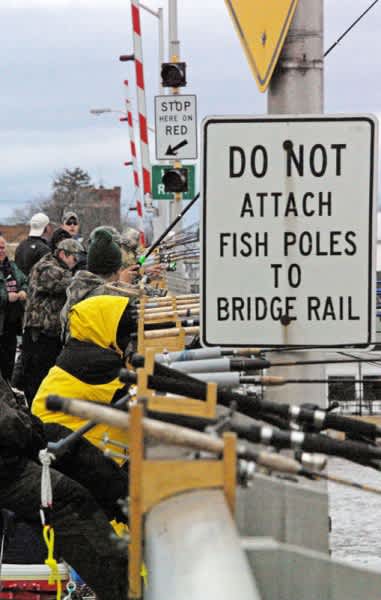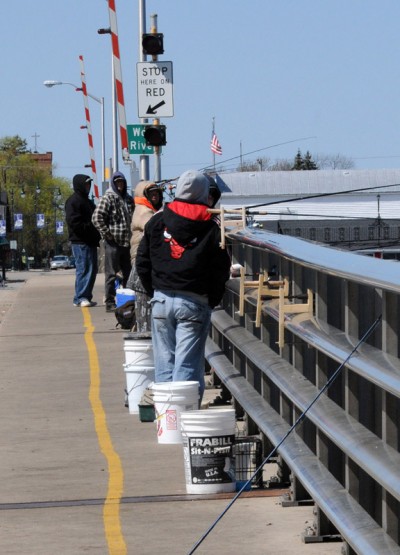Simple Ideas Preserve a Wisconsin Fishing Tradition
Patrick Durkin 05.05.14

The fading yellow line weaving and stuttering up the north sidewalk of the Highway 116 bridge over the Wolf River in east-central Wisconsin looks like something teenage brothers painted to split their bedroom.
Though ugly, it’s effective. Walleye fishermen lining the bridge’s rails keep their chairs, buckets, cushions, coolers, six-packs, tackle boxes, snoozing kids, and themselves inside the stripe. That gives pedestrians room to squeeze past without stepping onto the road. Peer pressure more than police compel compliance.
The staggering stripe—applied in spring 2012 at the Village Board’s order—is a great example of a village, politicians, and state agencies cooperating to preserve a fishing tradition that’s unique to Winneconne. With the state Department of Transportation’s (DOT) blessing, this is Wisconsin’s only state-maintained bridge that doubles as a public fishing pier.
The bridge’s south sidewalk doesn’t sport a matching yellow stripe. That’s because fishing from the south sidewalk is restricted to 9 p.m. through 6 a.m., when bicyclists and pedestrians are scarce. Plus, the south side sports 10-foot wide, 80-foot long fishing platforms on both sides of the bridge’s center-lift spans.
The village, population 2,400, built the two 800-square-foot platforms with grants from the Wisconsin Department of Natural Resources (DNR) to ensure public-fishing access. As with the bridge’s north sidewalk, the platforms are open 24/7 year-round.
Unfortunately, if given a choice, many fishermen avoid the bridge’s south side. The north sidewalk tends to offer better fishing, says Chris “Critter” Boucher, owner of Critter’s Wolf River Sports shop about a half-mile away.
Boucher, who also serves on Winneconne’s village board, said anglers like to fish “the shadow” on the bridge’s north, upriver side. That’s where walleyes often congregate, using the bridge for shade to avoid sunlight by day and streetlights by night.
Not only that, but it’s easier for anglers to work their minnows or leeches among the underwater “structure” from the bridge’s north side. After casting or lowering their bait, anglers use the Wolf’s current to work good spots beneath the bridge. What kind of structure holds walleyes?
Doug Nelson, Boucher’s step-father and owner of The Wolf River House just northeast of the bridge, claims some structure is cement chunks that fell from the bridge during its rehabilitation in 1989.
“When the construction barges started filling up, it seemed the jackhammer guys worked even faster,” Nelson said. “As they busted up the cement, a lot of it fell onto the barge, bounced down the pile, and rolled into the water.”
During that project 25 years ago, the DOT resisted assumptions by the village, DNR, and anglers that the bridge would remain open to fishing. Although the DOT eventually surrendered, anglers hated the bridge’s new railings, whose height and design made fishing difficult.

Not only that, but the DOT mounted signs reading, “Do Not Attach Poles to Bridge Rails.” Well, the locals said that could not stand. But rather than stop and fight the DOT, the anglers adopted a trusty, time-honored legal maneuver: They ran for it, gambling that no cop, sheriff, or game warden would bother tackling them.
Sure enough, village elders winked and the state looked away as anglers mounted custom-designed rod-holders to the railings and kept fishing. This launched a cottage industry for local craftsmen, who build wood and aluminum rod-holders custom-fit for the railings. Nelson and Boucher sell the holders for about $10 each or two for $18.
So, they’re outlaws and accomplices, right?
“The fishermen aren’t attaching rods to the bridge,” Boucher said with a shrug. “They’re attaching rod-holders, and rod-holders don’t scratch the bridge. If the guys attached their rods with a bungee cord, they’d scratch it. They don’t want the state spending money for repainting.”
Boucher said this cooperative spirit makes the Winneconne bridge a great place to fish. Litter is seldom a problem, and squabbles are rare because most anglers quickly learn “bridge etiquette.”
What does that entail? “Don’t hog space, don’t cast into boats, and if a guy nearby is fighting a fish, move your line out of the way,” Boucher said. “When lifting your fish over the rail, don’t fling it. I’ve seen fish fly off the hook and hit passing cars. If you use a landing net, watch the traffic as you swing the net over the rail. Some guys look the wrong way and almost hit passing vehicles.”
Not just any landing net works on the Winneconne bridge, of course. To scoop hooked walleyes while fishing from high above, bridge-anglers use nets with 20-foot handles. Boucher sells those, too.
In fact, about the only unsettled bridge-borne controversy involves these long-handled, locally made nets. Anglers usually lay their net’s handle on the roadside, but tight to the sidewalk, and lean the net itself against the sidewalk’s ledge.
Yes, that means they’re outside the yellow stripe. Although no one claims a net has caused a pile-up or fender-bender, village officials have heard complaints and keep exploring options for keeping the nets off the road.
Meanwhile, Boucher and Nelson watch each spring as the bridge produces some of Wisconsin’s best walleye fishing. Boucher said anglers often show up around noon to claim a spot so they’re ready when the best action starts 10 hours later.
“Some years we’ve seen guys standing two-deep, waiting for the guy at the rail to catch his limit (five walleyes),” Boucher said.
Doesn’t that put the second guy outside the yellow line? Well, that takes care of itself, too, without government interference.
“On good nights, they aren’t waiting long,” Boucher said. “On slow nights, they aren’t two deep.”

